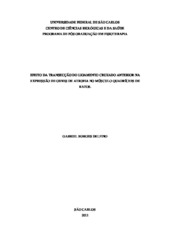Mostrar el registro sencillo del ítem
Efeito da transecção do ligamento cruzado anterior na expressão de genes de atrofia no músculo quadríceps de ratos
| dc.contributor.author | Delfino, Gabriel Borges | |
| dc.date.accessioned | 2016-06-02T20:18:16Z | |
| dc.date.available | 2011-12-12 | |
| dc.date.available | 2016-06-02T20:18:16Z | |
| dc.date.issued | 2011-11-28 | |
| dc.identifier.citation | DELFINO, Gabriel Borges. Efeito da transecção do ligamento cruzado anterior na expressão de genes de atrofia no músculo quadríceps de ratos. 2011. 153 f. Tese (Doutorado em Ciências Biológicas) - Universidade Federal de São Carlos, São Carlos, 2011. | por |
| dc.identifier.uri | https://repositorio.ufscar.br/handle/ufscar/5135 | |
| dc.description.abstract | The quadriceps muscle weakness and atrophy after the anterior cruciate ligament (ACL) rupture, is present before and after its reconstruction, and are important limitations that restrict the return of subjects to activities of daily living and sports. The combination of reduced synthesis and increased levels of protein degradation results in a rapid loss of muscle protein. The rapid muscle proteolysis occurs in several animal models and in different conditions in humans, and are mainly associated to the ubiquitn proteasome system (UPS). Neuromuscular mechanisms are associated with atrophy and weakness of the quadriceps muscle after ACL rupture and reconstruction, but the molecular pathways involved in this process are unknown. The identification of these pathways may facilitate the establishment of therapeutic strategies to alleviate the muscle deficit. Thus, the objective of this thesis was to evaluate the effect of ACL transection of rats in the expression of genes of UPS (MuRF-1, Atrogina-1), as well as the expression of myostatin (involved in control of muscle mass) by the Real Time PCR (polymerase chain reaction) technique. It was evaluated the content of ubiquitinated proteins by Western blotting and the cross-sectional area of muscle fibers (CSA) of the vastus medialis (VM), rectus femoris (RF) and vastus lateralis (VL) of the quadriceps. Elevated Atrogin-1, MuRF-1 and myostatin mRNA levels were observed after ACL transection in all muscles assessed, as the reduction of CSA in VM and VL muscles. The results of this thesis contributed to the understanding of the mechanisms of quadriceps muscle atrophy after ACL transection. | eng |
| dc.description.sponsorship | Universidade Federal de Minas Gerais | |
| dc.format | application/pdf | por |
| dc.language | por | por |
| dc.publisher | Universidade Federal de São Carlos | por |
| dc.rights | Acesso Aberto | por |
| dc.subject | Fisioterapia | por |
| dc.subject | Ubiquitina | por |
| dc.subject | Atrofia muscular | por |
| dc.subject | Reabilitação | por |
| dc.subject | Músculo quadríceps | por |
| dc.subject | Estimulação elétrica | por |
| dc.subject | Ubituin-Proteasome | eng |
| dc.subject | Muscle atrophy | eng |
| dc.subject | Rehabilitation | eng |
| dc.subject | Quadriceps | eng |
| dc.subject | ACL | eng |
| dc.title | Efeito da transecção do ligamento cruzado anterior na expressão de genes de atrofia no músculo quadríceps de ratos | por |
| dc.type | Tese | por |
| dc.contributor.advisor1 | Salvini, Tânia de Fátima | |
| dc.contributor.advisor1Lattes | http://genos.cnpq.br:12010/dwlattes/owa/prc_imp_cv_int?f_cod=K4783618J3 | por |
| dc.description.resumo | A atrofia e fraqueza do quadríceps após a ruptura do ligamento cruzado anterior (LCA), presentes antes e após sua reconstrução, são importantes limitações que restringem o retorno dos indivíduos às atividades da vida diária e desportivas. A rápida proteólise muscular que ocorre nos diversos modelos animais e em diferentes condições em humanos se deve, principalmente, ao sistema ubiquitna proteassoma (UPS). Mecanismos neuromusculares são associados à atrofia e fraqueza do quadríceps após a ruptura e reconstrução do LCA, porém as vias moleculares envolvidas nesse processo são desconhecidas. A identificação dessas vias pode favorecer o estabelecimento de estratégias terapêuticas para amenizar o déficit muscular. Assim, o objetivo dessa tese foi avaliar o efeito da transecção do LCA de ratos na expressão dos genes pertencentes ao UPS (MuRF-1, a Atrogina-1), e também da Miostatina (envolvida no controle da massa muscular) pela técnica de PCR (reação em cadeia da polimerase) em tempo real no quadriceps. Avaliou-se ainda o conteúdo de proteínas ubiquitinadas por Western Blotting e a área de secção transversa das fibras musculares (AST) dos músculos Vasto Medial (VM), Reto Femoral (RF) e Vasto Lateral (VL). Níveis elevados de Atrogina-1, MuRF-1 e Miostatina ocorreram após transecção do LCA em todos os músculos avaliados assim como a redução da AST nos músculos VM e VL. Os resultados desta tese contribuiram para a compreensão dos mecanismos de atrofia do quadríceps após a transecção do LCA. | por |
| dc.publisher.country | BR | por |
| dc.publisher.initials | UFSCar | por |
| dc.publisher.program | Programa de Pós-Graduação em Fisioterapia - PPGFt | por |
| dc.subject.cnpq | CIENCIAS DA SAUDE::FISIOTERAPIA E TERAPIA OCUPACIONAL | por |
| dc.contributor.authorlattes | http://lattes.cnpq.br/1004379121741653 | por |
